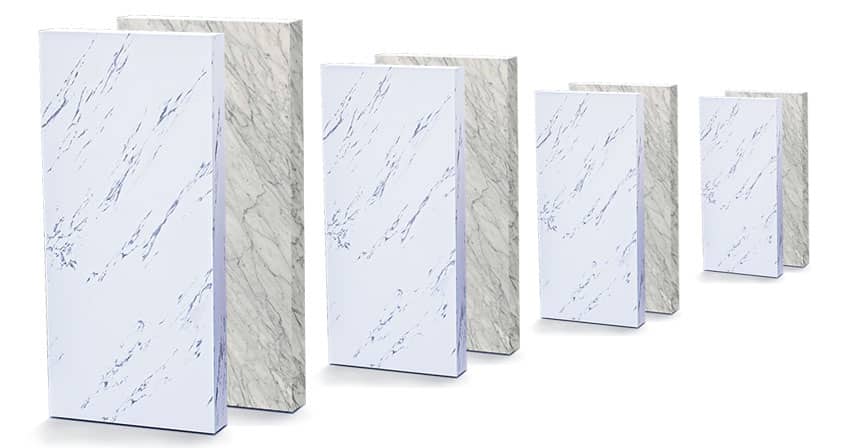Thinking about granite for your next project but feeling overwhelmed by the different slab sizes available? You’re not alone! Granite is a top choice for many construction projects due to its flexibility and durability. Whether you’re interested in slabs or tiles, granite comes in various sizes tailored to fit your needs. From standard dimensions to custom cuts, you can find the perfect granite slab to suit your specific project requirements.

Granite offers a range of sizes, each ideal for different applications. Whether you’re outfitting a new countertop, flooring, or undergoing a major renovation, understanding the different granite slab sizes can make a huge difference. In this guide, we’ll break down the various granite slab sizes on the market and help you determine the best fit for your project. We’ll cover everything from standard sizes to custom options and discuss the factors to consider when choosing the right size, including dimensions and thickness.
Keep in mind that standard sizes may vary based on region or manufacturer, so it’s a good idea to check with local suppliers to find out what’s available in your area. By the end of this guide, you’ll have the knowledge you need to make an informed decision and ensure your granite project turns out just as you envisioned. Let’s get started!
What Is The Size Of A Slab Of Granite?
Granite slabs vary in size depending on the market and region, so it’s helpful to understand the different types available:
In India, South Eash Asia and Some African Countries: Cutter-sized granite slabs are prevalent, ranging from about 250 cm x 60 cm (approximately 98 inches x 24 inches) to 330 cm x 100 cm (about 130 inches x 39 inches). These slabs typically have a thickness of 1.6 cm to 2 cm (about 0.6 inches to 0.8 inches). They are favored for their affordability and ease of handling, making them popular for domestic projects.
In the American Market: Gangsaw and Jumbo gangsaw slabs are more common and are generally much larger than cutter-sized slabs. They typically measure up to 130 inches x 80 inches and are usually 3 cm thick (about 1.25 inches). These slabs offer greater consistency and are ideal for larger, more expansive projects.
In Europe: Both gangsaw and jumbo gangsaw slabs are prevalent. Standard thicknesses in Europe are generally around 2 cm (about 0.75 inches), with dimensions similar to those found in the US. Jumbo gangsaw slabs offer even larger sizes, suitable for high-end installations and large-scale projects.
Understanding these sizes can help you choose the right granite slab for your project. Let’s dive into the details of each type to get a clearer picture of what might be best for your needs.
Also READ | Exploring Granite Tiles: Sizes, Applications, and Varieties for Kitchen Countertop and Floor
Cutter-size Granite Slab (Also Known as Vertical Granite Slab)
In India, granite slab size typically measure 3 feet x 8 feet or 900mm x 2400mm. However, the dimensions of granite slabs can range from 3 feet to 4 feet in width and 8 feet to 12 feet in length.
Cutter granite slabs, smaller and thinner than gang saw-sized counterparts, are popular in India’s domestic markets and some of Asian and African countries. Valued for their affordability and easier handling, they offer a cost-effective choice.
 Vertical or Cutter Size Granite slab
Vertical or Cutter Size Granite slab
Gangsaw Size Granite Slabs
Gangsaw granite slab size are favoured for their reliability, consistency, and strength. These slabs are ideal for showcasing the full beauty of granites with extensive patterns. These slabs can measure up to 130 x 80 inches and are cut using a gang saw or wire saw machine.

- Jumbo-Size Granite Slabs
Jumbo-size granite slab size are commonly used in large-scale construction projects such as commercial buildings, skyscrapers, and expansive flooring applications. The main advantage is their ability to cover larger surface areas with fewer seams, providing a more seamless and aesthetically pleasing look. Additionally, using jumbo-size granite slabs reduces the number of joints and grout lines, enhancing the overall durability and structural integrity of the installation. Typically, they are cut using a gang saw machine and can measure up to 150 x 80 inches.

How Thick Are Standard Slabs of Granite?
Standard thickness for granite slabs can vary from country to country and even between regions or quarries within the same country. Globally, there are a handful of common standard thickness dimensions.
In India, the standard thickness is ranging from 16 mm to 20 mm in order to minimise the price per square feet.
- 2-centimetre-thick slabs are typically utilised for interior applications such as countertops and vanities.
- 3 cm-thick slabs are typically used for kitchen countertops, bar tops, and outdoor kitchens because they are thicker and more durable.
- 4 cm thick slabs: These are the thickest natural stone slabs available and are typically used for premium kitchen countertops, flooring and exterior cladding in high-traffic areas
ALSO READ | What Is the Ideal Granite Thickness for Countertops?
 Various Granite Thickness
Various Granite Thickness
Custom Cut Granite (Also referred to as Cut-to-Size Granite Slabs):
Custom cut granite slabs are cut to order from larger blocks of natural stone to meet the specific requirements of each project. These granite slabs can be sized to fit a particular space, such as a kitchen island or shower wall, flooring or for that matter anything. Additionally, they can be cut to precise thicknesses or shapes, such as curved edges or unusual angles.
Tailoring the size of granite slabs to specific project requirements not only contributes to significant cost savings by minimizing material wastage but is also essential for specialized applications. To make the custom sizing process economically viable, it is crucial to have a substantial quantity of requirements for ordering.
ALSO READ | Granite for Building: Exploring the Differences Between Granite Slabs and Tiles
 Custom Cut Granite Slab
Custom Cut Granite Slab
Custom Thickness of Granite Slabs
Producing granite slabs with custom thicknesses is a common practice. Ordering granite slabs with custom thicknesses is a more straightforward process compared to custom sizing of entire slabs.
ALSO READ | Custom Cut Granite: Stair Tiles for Staircase
What Are the Pros and Cons of Using Granite Slabs in Standard Size Versus Custom Size?
Standard Sizes:
Pros:
-
- Easier to source and readily available
- Usually more affordable than custom sizes.
- Can be used in a wide range of projects
- Can be easier to install and work with due to familiarity with the size.
Cons:
-
- May not fit certain project requirements.
- May result in more waste due to needing to cut pieces to fit.
- Can limit creativity in design and layout.
- May not be able to achieve a specific look or pattern with standard sizes.
Custom Size:
Pros:
-
- Can be tailored to specific project requirements.
- Can result in less waste due to needing fewer cuts.
- Allows for more creative design and layout possibilities.
- Can achieve a specific look or pattern that may not be possible with standard sizes.
Cons:
-
- Can be more expensive than standard sizes.
- May take longer to source and produce
- May require more expertise to work with and install
- May not be readily available from all suppliers or quarries.
Tips for Choosing the Right Granite Slab Size
When choosing the right granite slab size for your project, there are a few things to consider:
- Project Size: Consider the size of your project as well as the amount of surface area that must be covered. Smaller projects may only need a partial slab or a custom-sized piece, whereas larger projects will require larger slabs.
- Aesthetics: Consider how the size of the slab will influence the design elements of your project. For instance, a larger slab may permit a seamless appearance with fewer visible seams, whereas a smaller slab may necessitate more seams. Smaller slabs can provide a more traditional or rustic appearance, while larger slabs can create a more modern or contemporary appearance.
- Budget: Consider your budget when choosing the size of your slab. Larger slabs will be more expensive than smaller ones, so it’s important to choose a size that fits your budget.
- Granite Supplier: Work with a reputable supplier who can provide guidance on the right size slab for your project and help you navigate the various options.
Why is It Essential to Choose the Correct Granite Slabs Size?
- Aesthetics: The size of the natural stone slabs can affect the project’s overall design aesthetic. Choosing the incorrect size can lead to an unbalanced or unattractive appearance. Choosing slabs that are too small for a large space, for instance, can make the area feel cluttered and cramped.
- Functionality is another factor to consider when selecting natural stone slabs. If you choose a slab that is too small for the intended application, it may not provide sufficient support or coverage. This can compromise the stone’s durability and longevity, resulting in expensive repairs or replacements.
- Budget: Choosing the proper size of natural stone slabs is also important from a financial standpoint. Custom and larger slab sizes can be more expensive than standard slab sizes, so it is essential to consider your budget when choosing slab sizes. Selecting the incorrect size can result in wasteful expenditures on materials, labour, and installation.
- Installation: The installation process can be affected by the size of the natural stone slabs. Choosing the incorrect size may result in additional labour or installation costs, as well as potential installation delays or complications.
Choosing Correct Granite Slab Size Promotes Sustainability
Selecting the appropriate of granite slab size for a project can help reduce waste and promote sustainability.
- Selecting the appropriate size of granite for a project can help reduce waste by minimising the amount of excess material that must be removed or cut away. So its advisable to use custom cut granite which only reduces wastage but also increase logistics efficiency.
- Selecting natural stones that are close to the desired dimensions reduces the need for additional processing, resulting in less waste and fewer carbon emissions from manufacturing processes.
- Using larger stones frequently results in fewer joints, which can help reduce waste and improve installation efficiency.
- Selecting stones that are suitable for the project’s requirements can help ensure that the proper amount of material is used, thereby reducing the need for excess and minimising waste.
- Selecting the appropriate size of natural stone can also contribute to a more sustainable outcome by reducing transportation costs and emissions, as larger stones can frequently be transported more efficiently than smaller ones.
- By minimising waste, selecting the appropriate size of natural stone can also reduce the overall cost of a project and improve its long-term viability.
Conclusion
Since granite slabs can be cut to almost any size, they can be used in a wide variety of building and remodelling projects. Granite slabs come in a wide variety of sizes, so it’s important to take into account the dimensions of your space, the style you’re going for, your budget, and other factors when making your selection. If you’re having trouble deciding on the right size of granite slabs for your project, expert stone supplier can assist you.





